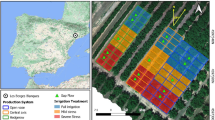Abstract
The current development of satellite technology particularly in the sensors like POLDER and MISR, has emphasized more on directional reflectance measurements (i.e. spectral reflectance of the target measured from different view zenith and azimuth angles) of the earth surface features mainly the vegetation for retrieval of biophysical parameters at regional scale using radiative transfer models. This approach being physical process based and uses directional reflectance measurement has been found to better and more reliable compared to the conventional statistical approach used till date and takes care of anisotropic nature (i.e. reflectance from the target is different if measured from different view angles) of the target. Keeping this in view a field experiment was conducted in mustard crop to evaluate the radiative transfer model for biophysical parameter retrieval through its inversion with the objectives set as (i) to relate canopy biophysical parameters and geometry to its bidirectional reflectance, (ii) to evaluate a canopy reflectance model to best represent the radiative transfer within the canopy for its inversion and (iii) to retrieve crop biophysical parameters through inversion of the model. Two varieties of the mustard crop (Brassica juncea L) were grown with two nitrogen treatments. The bidirectional reflectance data obtained at 5 nm interval for a range of 400–1100 nm were integrated to IRS LISS–II sensor’s four band values using Newton Cotes Integration technique. Biophysical parameters like leaf area index, leaf chlorophyll content, leaf length, plant height and average leaf inclination angle, biomass etc were estimated synchronizing with the bi-directional reflectance measurements. Radiative transfer model PROSAIL model was validated and its inversion was done to retrieve LAI and ALA. Look Up Table (LUT) of Bidirectional reflectance distribution function (BRDF) was prepared simulating through PROSAIL model varying only LAI (0.2 interval from 1.2 to 5.4 ) and ALA (5° interval from 40° to 55°) parameters and inversion was done using a merit function and numerical optimization technique given by Press et al. (1986). The derived LAI and ALA values from inversion were well matched with observed one with RMSE 0.521 and 5.57, respectively.







Similar content being viewed by others
References
Arnon, D. I. (1949). Copper enzyme in isolated chloroplast. Polyphenol oxidase in Beta vulgaris. Plant Physiology, 24, 1–15.
Asrar, G., Fuchs, M., Kanemasu, E. T., & Hatfield, J. L. (1984). Estimating absorbed photosynthetic radiation and leaf area index from spectral reflectance in wheat. Agronomy Journal, 64, 368–373.
Bicheron, P., & Leroy. (1999). A method of biophysical parameter retrieval at global scale by inversion of a vegetation reflectance model. Remote Sensing of Environment, 67(3), 251–266.
Casa, R., & Jones, H. G. (2004). Retrieval of crop canopy properties: a comparison between model inversion from hyperspectral data and image classification. International Journal of Remote Sensing, 23, 1119–1130.
Goel, N. S. (1987). Models of vegetation canopy reflectance and their use in estimation of biophysical parameters from reflectance data. Remote Sensing Review, 1, 221.
Goel, N. S. (1988). Estimation of canopy parameters for in homogenous vegetation canopies from reflectance data.III TRIM: A model for radiative transfer in heterogeneous three—dimensional canopies. Remote Sensing of Environment, 25, 255–293.
Goel, N. S. (1989). Inversion of canopy reflectance models for estimation of biophysical parameters from reflectance data. In G. Asrar (Ed.), Theory and applications of optical remote sensing (pp. 205–250). New York: Wiley Interscience.
Jacquemoud, S. (1993). Inversion of the PROSPECT+SAIL canopy reflectance model from AVIRIS equivalent spectra: theoretical study. Remote Sensing of Environment, 44(2–3), 281–292.
Kimes, D. S., & Sellers, P. J. (1985). Inferring hemispherical reflectance of the earth’s surface for global energy budgets from remotely sensed nadir of directional radiance values. Remote Sensing of Environment, 18, 205–223.
Mikkawy, E., & Moawwad. (2003). A unified approach to Newton-Cotes quadrature formulae. Applied Mathematics and Computation (New York), 138(2–3), 403–413.
Myneni, R. B., & Ross, J. (1991). Photon-Vegetation interactions: applications in optical remote sensing and plant ecology. New York: Springer.
Nelder, & Mead. (1965). Computer Journal, 7, 308–313.
Nilson, T., & Kuusk, A. (1989). A reflectance model for the homogeneous plant canopy and its inversion. Remote Sensing of Environment, 27, 157–167.
Suits, G. H. (1972) The calculation of bidirectional reflectance of a vegetation canopy. Remote Sensing of Environment, 2, 117–125.
Acknowledgements
First author thanks Indian Agricultural Research Institute, New Delhi for providing Junior Research Fellowship for this study.
Author information
Authors and Affiliations
Corresponding author
About this article
Cite this article
Tripathi, R., Sahoo, R.N., Sehgal, V.K. et al. Inversion of PROSAIL Model for Retrieval of Plant Biophysical Parameters. J Indian Soc Remote Sens 40, 19–28 (2012). https://doi.org/10.1007/s12524-011-0129-8
Received:
Accepted:
Published:
Issue Date:
DOI: https://doi.org/10.1007/s12524-011-0129-8




